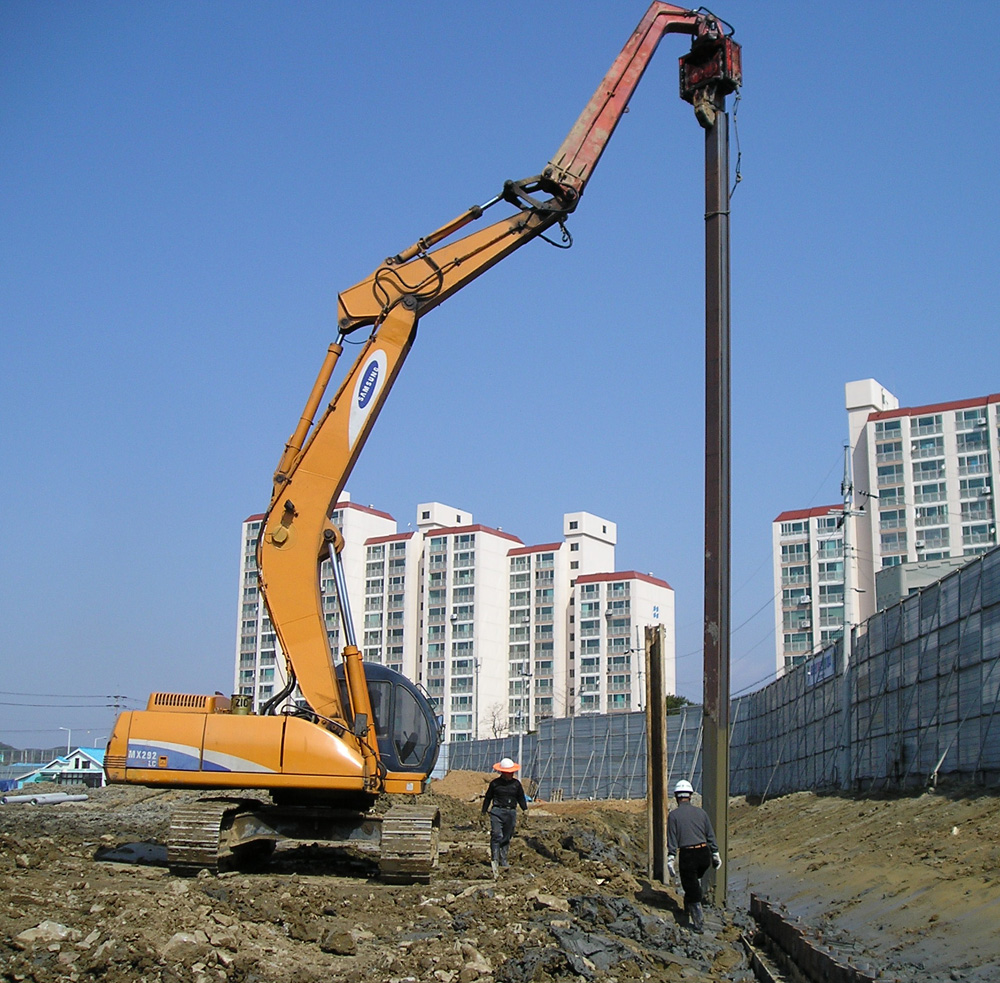Bored piles
Contents |
[edit] Introduction
Bored piles, also known as replacement piles, are a commonly-used form of building foundation that provide support for structures, transferring their load to layers of soil or rock that have sufficient bearing capacity and suitable settlement characteristics.
Bored piles are piles where the removal of spoil forms a hole for a reinforced concrete pile which is poured in situ. The spoil is replaced by the pile, hence 'replacement' piles as opposed to displacement piles where soil is forced away by driving or screwing the pile.
Bored piles are used primarily in cohesive subsoils for the formation of friction piles and when forming pile foundations close to existing buildings. They are popular in urban areas as there is minimal vibration, where headroom is limited, where there is no risk of heave, and if there is a need to vary the length of the piles.
[edit] Installation
Bored piles are drilled using buckets and/or augers driven by percussion boring (vibratory hammers) or through rotary boring (twisting in place).
In unstable soil strata, the use of bentonite fluid assists in stabilising the bore especially in large diameter deeper piles and allows the insertion of heavily reinforcing steel cages. This is known as flush boring (see more below).
If the boring and pouring takes place simultaneously, piles are known as continuous flight auger (CFA) piles.
Piles are known as large diameter piles if they are 600 mm or more in diameter. Small diameter piles of less than 600 mm are sometimes placed in groups under a common pile cap to receive heavy loads.
Large diameter piles can have their bearing capacity increased by under-reaming the shaft at the base. This is achieved by an expanding cutting tool which cuts a conical-shaped base up to three times the diameter of the main shaft.
The form of support to the pile or borehole affects the pile formation. Bored piles can be either supported or unsupported.
[edit] Unsupported piles
Where piling is undertaken in stable soils it may be possible to bore and place the concrete without first lining the hole. However, precautions need to be taken by lining the first metre of the hole to prevent surface spoil from falling into the hole.
[edit] Supported piles
There are two categories of supported pile depending on the casing or lining that is used.
[edit] Permanent casing
The borehole can be formed by the percussion method which involves a heavy cutting tool on a small tripod which is dropped from its raised position using a winch to cut out a cylinder of earth. The operation is repeated until the hole has been sunk to the required depth. As the cutting proceeds, a thin sectional lining is inserted into the hole to prevent its collapse. Alternatively, the borehole can be formed by the rotary method in which the rotary drill operates within the casing or lining.
[edit] Temporary casing
It is common for the borehole to be supported by a screw-jointed steel lining which is removed either during or after the concrete has been placed. The tube can be winched or jacked out of the ground.
Flush boring uses a fluid such as bentonite to flush material from the hole, which has been loosened by drilling. The fluid can be poured from above (reverse flushing) or pumped through the drilling rod (direct flushing). The bored hole is lined with a temporary steel casing to prevent collapse of loose surface soil. As the boring proceeds, bentonite is continuously fed into the hole.
At the required depth, reinforcement is lowered through the bentonite and concrete poured. The bentonite is displaced by the concrete and pumped back up out of the hole. As the concrete reaches the hole’s upper level, the temporary casing is withdrawn.
[edit] Related articles on Designing Buildings
- Continuous flight auger piles.
- Driven piles.
- End-bearing piles.
- Foundations.
- Friction piles.
- Geothermal pile foundations.
- Groundworks.
- Ground anchor.
- Micropiles.
- Moorfields building sets UK pile-loading record.
- Pad foundation.
- Pile cap.
- Pile foundations.
- Pile integrity test.
- Piling equipment.
- Screw piles.
- Secant pile wall.
- Sheet piles.
- Socket piles.
- Tension piles.
- Testing pile foundations.
- Types of pile foundation.
- Underpinning.
[edit] External resources
- ‘Introduction to Civil Engineering Construction’ (3rd ed.), HOLMES, R., College of Estate Management (1994)
- ‘Building Construction Handbook’ (6th ed.), CHUDLEY, R., .GREENO, R., Butterworth-Heinemann (2006)
Featured articles and news
Moisture, fire safety and emerging trends in living walls
How wet is your wall?
Current policy explained and newly published consultation by the UK and Welsh Governments.
British architecture 1919–39. Book review.
Conservation of listed prefabs in Moseley.
Energy industry calls for urgent reform.
Heritage staff wellbeing at work survey.
A five minute introduction.
50th Golden anniversary ECA Edmundson apprentice award
Showcasing the very best electrotechnical and engineering services for half a century.
Welsh government consults on HRBs and reg changes
Seeking feedback on a new regulatory regime and a broad range of issues.
CIOB Client Guide (2nd edition) March 2025
Free download covering statutory dutyholder roles under the Building Safety Act and much more.
AI and automation in 3D modelling and spatial design
Can almost half of design development tasks be automated?
Minister quizzed, as responsibility transfers to MHCLG and BSR publishes new building control guidance.
UK environmental regulations reform 2025
Amid wider new approaches to ensure regulators and regulation support growth.
The maintenance challenge of tenements.
BSRIA Statutory Compliance Inspection Checklist
BG80/2025 now significantly updated to include requirements related to important changes in legislation.
Shortlist for the 2025 Roofscape Design Awards
Talent and innovation showcase announcement from the trussed rafter industry.

























Comments